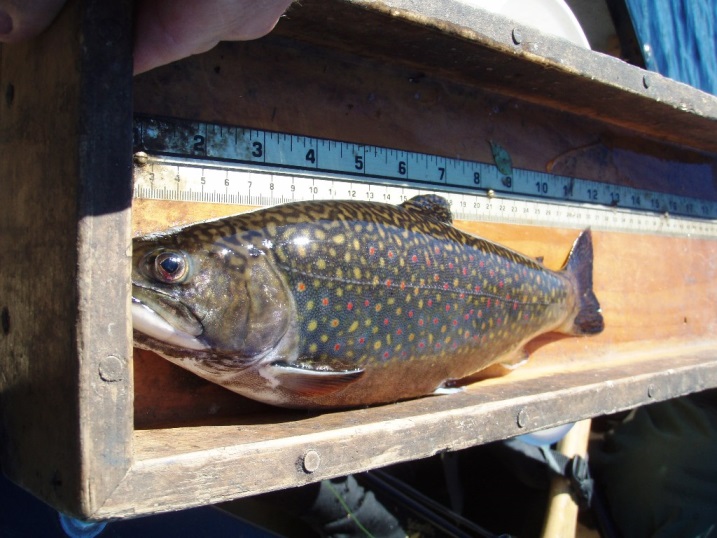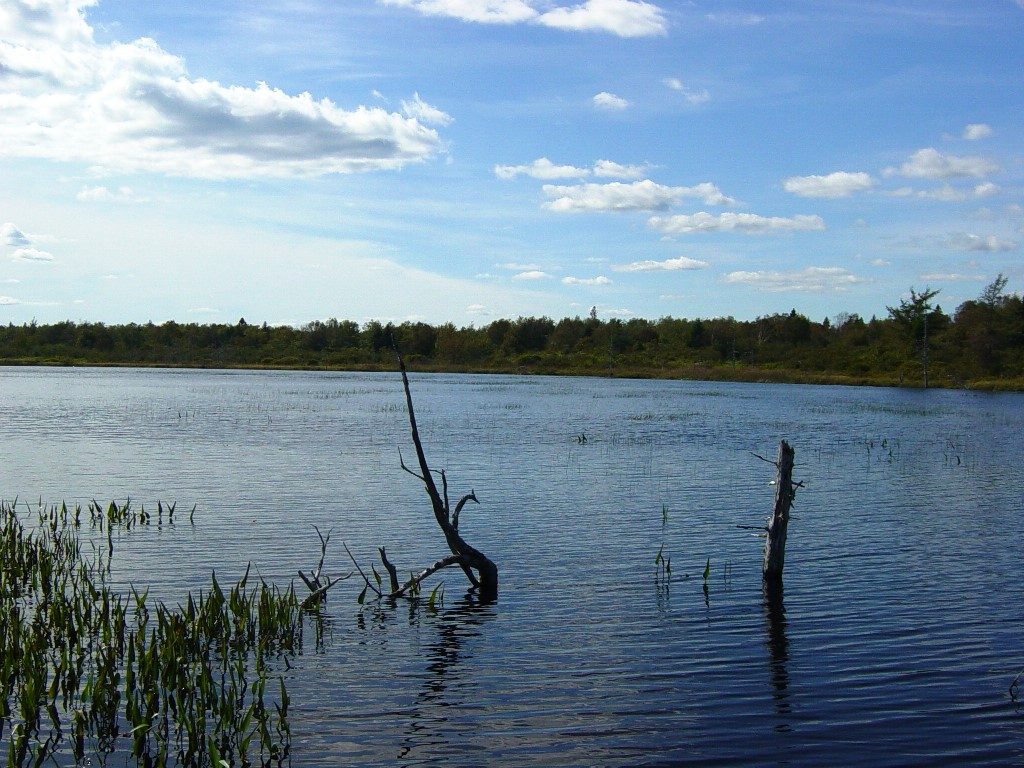October 21, 2016 at 12:47 pm
[caption id="attachment_2007" align="alignright" width="550"] Plump brook trout like this one benefit from the cooler microclimate and seeping springs that one finds near the ocean downeast.[/caption]
By IFW Fisheries Biologist Greg Burr
Typically, in Downeast Maine a successful brook trout pond (whether stocked or wild) possesses some shared characteristics. The usual set-up is a pond that is cold, well oxygenated and has a simple fish assemblage.
This often translates to a pond that stratifies into three layers during the mid-summer with a warm surface layer (called the epilimnion), a well oxygenated middle transition layer that rapidly shifts from warm to cold (called the thermocline), and a deep cold, well oxygenated bottom layer (called the hypolimnion).
Brook trout spend most of their time during the summer months in the colder layers, while occasionally making short feeding forays into warmer water. What has just been described is the classic success set-up for brook trout, where trout grow and survive to older ages and larger sizes.
Now consider two Downeast brook trout waters, Norse Pond in Cutler and Simpson Pond in Roque Bluffs. At first glance these ponds appear to be too shallow and too warm to support viable brook trout fisheries. Both have a maximum depth of only 6 feet and during the mid-summer the water temperature is the same from top to bottom (known as homothermous). Homothermous ponds typically have plenty of oxygen but lack the cool layers that brook trout require during the summer.
Both Norse Pond and Simpson Pond produce trout up to 16-18 inches! So what makes these waters so successful? Well, both are within in a stone’s throw of the ocean and cool breezes and foggy mornings keep the waters cooler than waters further inland.
But the most important habitat feature that makes these ponds unique and habitable for trout, are the spring fed boggy areas that surround both ponds. These areas often found along the coastal plain, give Norse Pond and Simpson Pond the cold-water refuge brook trout need to survive the warmer periods of the year.
In these situations, trout will hang around, and under, these cold (sometimes floating) boggy banks and will come out into the main body of water periodically to feed. This unique scenario breaks the typical trout pond mold in Downeast Maine, but it works.
Both of these fisheries are wildly popular and prove once again that Maine has some very special fishing opportunities. Both waters are open to fishing through the fall (check the law book for the complete list of regulations). So you still have time to get out and experience these unique brook trout fisheries!
[caption id="attachment_2008" align="aligncenter" width="1024"]
Plump brook trout like this one benefit from the cooler microclimate and seeping springs that one finds near the ocean downeast.[/caption]
By IFW Fisheries Biologist Greg Burr
Typically, in Downeast Maine a successful brook trout pond (whether stocked or wild) possesses some shared characteristics. The usual set-up is a pond that is cold, well oxygenated and has a simple fish assemblage.
This often translates to a pond that stratifies into three layers during the mid-summer with a warm surface layer (called the epilimnion), a well oxygenated middle transition layer that rapidly shifts from warm to cold (called the thermocline), and a deep cold, well oxygenated bottom layer (called the hypolimnion).
Brook trout spend most of their time during the summer months in the colder layers, while occasionally making short feeding forays into warmer water. What has just been described is the classic success set-up for brook trout, where trout grow and survive to older ages and larger sizes.
Now consider two Downeast brook trout waters, Norse Pond in Cutler and Simpson Pond in Roque Bluffs. At first glance these ponds appear to be too shallow and too warm to support viable brook trout fisheries. Both have a maximum depth of only 6 feet and during the mid-summer the water temperature is the same from top to bottom (known as homothermous). Homothermous ponds typically have plenty of oxygen but lack the cool layers that brook trout require during the summer.
Both Norse Pond and Simpson Pond produce trout up to 16-18 inches! So what makes these waters so successful? Well, both are within in a stone’s throw of the ocean and cool breezes and foggy mornings keep the waters cooler than waters further inland.
But the most important habitat feature that makes these ponds unique and habitable for trout, are the spring fed boggy areas that surround both ponds. These areas often found along the coastal plain, give Norse Pond and Simpson Pond the cold-water refuge brook trout need to survive the warmer periods of the year.
In these situations, trout will hang around, and under, these cold (sometimes floating) boggy banks and will come out into the main body of water periodically to feed. This unique scenario breaks the typical trout pond mold in Downeast Maine, but it works.
Both of these fisheries are wildly popular and prove once again that Maine has some very special fishing opportunities. Both waters are open to fishing through the fall (check the law book for the complete list of regulations). So you still have time to get out and experience these unique brook trout fisheries!
[caption id="attachment_2008" align="aligncenter" width="1024"] Norse Pond is one of those downeast ponds that may be shallow, but holds cool water throughout the year, allowing trout to reach sizes of 16-18 inches.[/caption]
Norse Pond is one of those downeast ponds that may be shallow, but holds cool water throughout the year, allowing trout to reach sizes of 16-18 inches.[/caption]
 Plump brook trout like this one benefit from the cooler microclimate and seeping springs that one finds near the ocean downeast.[/caption]
By IFW Fisheries Biologist Greg Burr
Typically, in Downeast Maine a successful brook trout pond (whether stocked or wild) possesses some shared characteristics. The usual set-up is a pond that is cold, well oxygenated and has a simple fish assemblage.
This often translates to a pond that stratifies into three layers during the mid-summer with a warm surface layer (called the epilimnion), a well oxygenated middle transition layer that rapidly shifts from warm to cold (called the thermocline), and a deep cold, well oxygenated bottom layer (called the hypolimnion).
Brook trout spend most of their time during the summer months in the colder layers, while occasionally making short feeding forays into warmer water. What has just been described is the classic success set-up for brook trout, where trout grow and survive to older ages and larger sizes.
Now consider two Downeast brook trout waters, Norse Pond in Cutler and Simpson Pond in Roque Bluffs. At first glance these ponds appear to be too shallow and too warm to support viable brook trout fisheries. Both have a maximum depth of only 6 feet and during the mid-summer the water temperature is the same from top to bottom (known as homothermous). Homothermous ponds typically have plenty of oxygen but lack the cool layers that brook trout require during the summer.
Both Norse Pond and Simpson Pond produce trout up to 16-18 inches! So what makes these waters so successful? Well, both are within in a stone’s throw of the ocean and cool breezes and foggy mornings keep the waters cooler than waters further inland.
But the most important habitat feature that makes these ponds unique and habitable for trout, are the spring fed boggy areas that surround both ponds. These areas often found along the coastal plain, give Norse Pond and Simpson Pond the cold-water refuge brook trout need to survive the warmer periods of the year.
In these situations, trout will hang around, and under, these cold (sometimes floating) boggy banks and will come out into the main body of water periodically to feed. This unique scenario breaks the typical trout pond mold in Downeast Maine, but it works.
Both of these fisheries are wildly popular and prove once again that Maine has some very special fishing opportunities. Both waters are open to fishing through the fall (check the law book for the complete list of regulations). So you still have time to get out and experience these unique brook trout fisheries!
[caption id="attachment_2008" align="aligncenter" width="1024"]
Plump brook trout like this one benefit from the cooler microclimate and seeping springs that one finds near the ocean downeast.[/caption]
By IFW Fisheries Biologist Greg Burr
Typically, in Downeast Maine a successful brook trout pond (whether stocked or wild) possesses some shared characteristics. The usual set-up is a pond that is cold, well oxygenated and has a simple fish assemblage.
This often translates to a pond that stratifies into three layers during the mid-summer with a warm surface layer (called the epilimnion), a well oxygenated middle transition layer that rapidly shifts from warm to cold (called the thermocline), and a deep cold, well oxygenated bottom layer (called the hypolimnion).
Brook trout spend most of their time during the summer months in the colder layers, while occasionally making short feeding forays into warmer water. What has just been described is the classic success set-up for brook trout, where trout grow and survive to older ages and larger sizes.
Now consider two Downeast brook trout waters, Norse Pond in Cutler and Simpson Pond in Roque Bluffs. At first glance these ponds appear to be too shallow and too warm to support viable brook trout fisheries. Both have a maximum depth of only 6 feet and during the mid-summer the water temperature is the same from top to bottom (known as homothermous). Homothermous ponds typically have plenty of oxygen but lack the cool layers that brook trout require during the summer.
Both Norse Pond and Simpson Pond produce trout up to 16-18 inches! So what makes these waters so successful? Well, both are within in a stone’s throw of the ocean and cool breezes and foggy mornings keep the waters cooler than waters further inland.
But the most important habitat feature that makes these ponds unique and habitable for trout, are the spring fed boggy areas that surround both ponds. These areas often found along the coastal plain, give Norse Pond and Simpson Pond the cold-water refuge brook trout need to survive the warmer periods of the year.
In these situations, trout will hang around, and under, these cold (sometimes floating) boggy banks and will come out into the main body of water periodically to feed. This unique scenario breaks the typical trout pond mold in Downeast Maine, but it works.
Both of these fisheries are wildly popular and prove once again that Maine has some very special fishing opportunities. Both waters are open to fishing through the fall (check the law book for the complete list of regulations). So you still have time to get out and experience these unique brook trout fisheries!
[caption id="attachment_2008" align="aligncenter" width="1024"] Norse Pond is one of those downeast ponds that may be shallow, but holds cool water throughout the year, allowing trout to reach sizes of 16-18 inches.[/caption]
Norse Pond is one of those downeast ponds that may be shallow, but holds cool water throughout the year, allowing trout to reach sizes of 16-18 inches.[/caption]